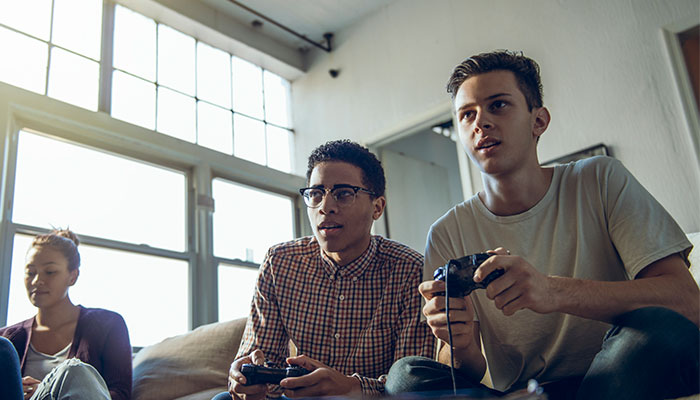Macquarie University psychology researchers have found that problematic screen use impairs a range of cognitive processes, in particular the ability to concentrate and the so-called executive functions, which include impulse control, planning, organisation and problem solving.

Their new paper, published in Neuropsychology Review, is an overview of more than 30 studies of people who fall into the broad category of disordered screen use.
The classification includes excessive gaming, internet browsing, or use of social media or smartphones, which result in serious negative effects on the person’s life.
These can include deterioration in mental health, poorer performance at school or work, social isolation and relationship problems, and neglect of personal health or hygiene.
Disordered screen use shares characteristics with behavioural addictions like problem gambling, and some people may even develop symptoms of severe dependency like those associated with addictions to alcohol and illicit substances.
The researchers identified 43 studies that assessed the neuropsychological effects of disordered screen use, ultimately including 34 in their analysis.
With so much of our work and leisure time based around screens, it has never been more important to assess their impact on cognitive functioning and overall wellbeing.
Twenty of the 34 included studies of online and offline gaming, 12 were on internet use, and one each on social media and smartphone use. The bias towards gaming and internet use were due to these platforms having been around longer, while smartphones and social media are relative newcomers to the screen-use landscape.
The research mostly looked at young males. Fifty-eight neuropsychological measures were tested, with most examining attention and executive functioning.
The need for consistency
The paper’s lead author, Macquarie neuropsychology researcher Mic Moshel, says the results of individual studies of disordered screen use over the years have been varied, with some showing improved attention and focus in specific areas and others showing marked deterioration.
“This is the first time anyone has reviewed all the available evidence together,” he says.
“The studies used different tests, which makes it more difficult to compare apples with apples, but there was clear evidence across the board of a reduction in cognitive performance in people with disordered screen use.
“While we can see there is an effect, the extent of that reduction is unclear because only eight of the studies assessed the severity of symptoms.
“To get a better idea of how severe and long-lasting these effects on brain function are, we need to see studies featuring comprehensive cognitive assessments rather than single tests, and incorporating all types of screen use, particularly more on social media and smartphones.
“With so much of our work and leisure time based around screens, it has never been more important to assess their impact on cognitive functioning and overall wellbeing.
“Having good-quality data is vital if we are to develop targeted remediation and treatment plans, and if the developers of technological platforms and devices are to take cognitive impacts into account during the design process.”
Impacts can compound over time
Previous research has shown that children and adolescents are the most vulnerable to disordered screen use, and developing brains are highly sensitive to cognitive impairment.

While cognitive impairment resulting from some other causes can be remediated, if left untreated, it can compound over time.
Mr Moshel says mild traumatic brain injury provides a good analogy, as it can lead to reduced cognitive performance that affects patients' ability to learn.
“If it is not remediated quickly and effectively, then you have what’s called the widening of the gap, where you see an increasing distance develop between these children and their peers academically.
“The effects of traumatic brain injury are well known, and cognitive remediation is one of the first things you do for a child in these circumstances.
“The difference with disordered screen use is that is not yet properly recognised as a cause of cognitive impairment. Often it is not even recognised that a child has disordered screen use in the first place.”
A growing problem
Currently, gaming disorders are the only type of problematic screen use to be formally classified as a mental health disorders.
Internet Gaming Disorder (IGD) was included in a section of the Diagnostic and Statistical Manual of Mental Disorders (DSM5) for new disorders requiring further study in 2013. Gaming Disorder (GD), and its sub-clinical cousin, Hazardous Gaming (HG), were ratified in the World Health Organisation’s International Classification of Disease (ICD-11) in 2019.
Pre-pandemic studies by Macquarie’s Associate Professor of Psychology Wayne Warburton and others found that about three per cent of young people in Australia and worldwide met the criteria for IGD, and between eight and 13 per cent were estimated to have some sort of HG-like problematic use.
A post-COVID study found the IGD figure had probably increased to around four per cent of young people in Germany.
- Dictionary of Lost Words: Sydney Theatre Company play review
- New project empowers migrant women to start businesses
“Gaming may be the only type of problematic screen use to have its own clinical diagnosis, but this is a topic of increasing debate,” says Associate Professor Warburton, one of the country’s leading experts on the effects of problematic screen use.
“It is clear to us that no matter what type of screen is involved, the disorder and its impacts look the same.
“Our review of the effects of disordered screen use on cognitive function supports this, with the same impacts recorded in studies looking at gaming and in excessive use of the internet, social media and smartphones. Gaming is simply the one that’s been around the longest.
“A 2021 study of recreational screen use found teenagers were averaging eight hours and 39 minutes a day. Most guidelines recommend no more than two to three hours.
“Clearly, this much screen use is cutting into time better spent sleeping, exploring, exercising and socialising face-to-face with friends and family, so it is entirely reasonable to think that a large percentage of our young people could be at risk of crossing the line into problematic and even disordered screen use.”
Associate Professor Wayne Warburton is an Associate Professor of Psychology in the School of Psychological Sciences at Macquarie University and a registered psychologist.
Mic Moshel holds a Master of Clinical Neuropsychology and is a PhD candidate at Macquarie University.



